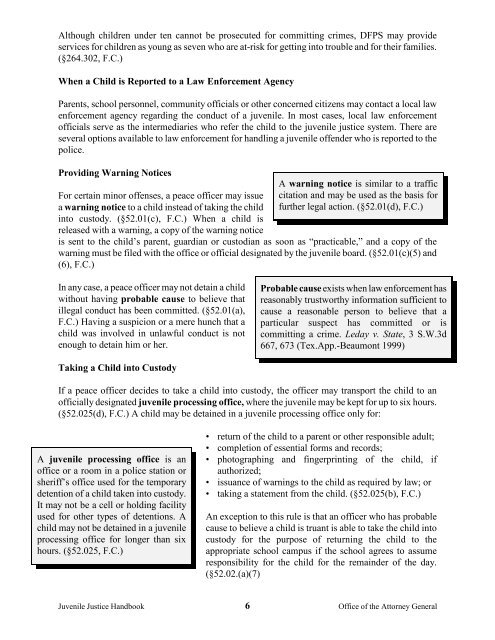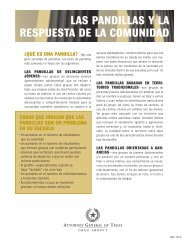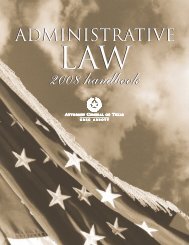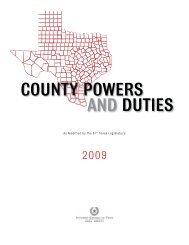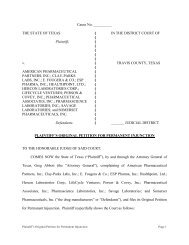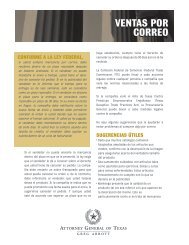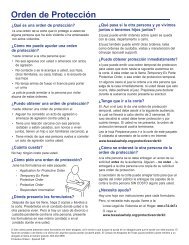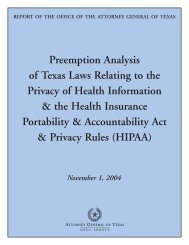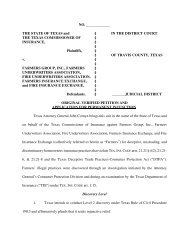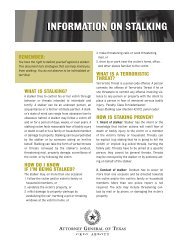Juvenile Justice Handbook - Texas Attorney General
Juvenile Justice Handbook - Texas Attorney General
Juvenile Justice Handbook - Texas Attorney General
You also want an ePaper? Increase the reach of your titles
YUMPU automatically turns print PDFs into web optimized ePapers that Google loves.
Although children under ten cannot be prosecuted for committing crimes, DFPS may provide<br />
services for children as young as seven who are at-risk for getting into trouble and for their families.<br />
(§264.302, F.C.)<br />
When a Child is Reported to a Law Enforcement Agency<br />
Parents, school personnel, community officials or other concerned citizens may contact a local law<br />
enforcement agency regarding the conduct of a juvenile. In most cases, local law enforcement<br />
officials serve as the intermediaries who refer the child to the juvenile justice system. There are<br />
several options available to law enforcement for handling a juvenile offender who is reported to the<br />
police.<br />
Providing Warning Notices<br />
For certain minor offenses, a peace officer may issue<br />
a warning notice to a child instead of taking the child<br />
into custody. (§52.01(c), F.C.) When a child is<br />
released with a warning, a copy of the warning notice<br />
A warning notice is similar to a traffic<br />
citation and may be used as the basis for<br />
further legal action. (§52.01(d), F.C.)<br />
is sent to the child’s parent, guardian or custodian as soon as “practicable,” and a copy of the<br />
warning must be filed with the office or official designated by the juvenile board. (§52.01(c)(5) and<br />
(6), F.C.)<br />
In any case, a peace officer may not detain a child<br />
without having probable cause to believe that<br />
illegal conduct has been committed. (§52.01(a),<br />
F.C.) Having a suspicion or a mere hunch that a<br />
child was involved in unlawful conduct is not<br />
enough to detain him or her.<br />
Probable cause exists when law enforcement has<br />
reasonably trustworthy information sufficient to<br />
cause a reasonable person to believe that a<br />
particular suspect has committed or is<br />
committing a crime. Leday v. State, 3 S.W.3d<br />
667, 673 (Tex.App.-Beaumont 1999)<br />
Taking a Child into Custody<br />
If a peace officer decides to take a child into custody, the officer may transport the child to an<br />
officially designated juvenile processing office, where the juvenile may be kept for up to six hours.<br />
(§52.025(d), F.C.) A child may be detained in a juvenile processing office only for:<br />
A juvenile processing office is an<br />
office or a room in a police station or<br />
sheriff’s office used for the temporary<br />
detention of a child taken into custody.<br />
It may not be a cell or holding facility<br />
used for other types of detentions. A<br />
child may not be detained in a juvenile<br />
processing office for longer than six<br />
hours. (§52.025, F.C.)<br />
• return of the child to a parent or other responsible adult;<br />
• completion of essential forms and records;<br />
• photographing and fingerprinting of the child, if<br />
authorized;<br />
• issuance of warnings to the child as required by law; or<br />
• taking a statement from the child. (§52.025(b), F.C.)<br />
An exception to this rule is that an officer who has probable<br />
cause to believe a child is truant is able to take the child into<br />
custody for the purpose of returning the child to the<br />
appropriate school campus if the school agrees to assume<br />
responsibility for the child for the remainder of the day.<br />
(§52.02.(a)(7)<br />
<strong>Juvenile</strong> <strong>Justice</strong> <strong>Handbook</strong> 6<br />
Office of the <strong>Attorney</strong> <strong>General</strong>


